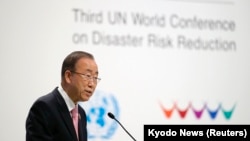As emergency assistance begins to arrive in cyclone devastated Vanuatu, an international conference on disaster risk reduction considered actions to assist threatened Pacific island nations in warding off future disasters.
The conference in Japan is pressing for greater global attention to issues of development and climate change.
The Asia Pacific community Sunday responded with offers of emergency assistance and medical aid to storm devastated Vanuatu, an archipelago of over 80 islands in the South Pacific, which bore the full force of Tropical Cyclone Pam.
Fears are held of a rising death toll as aid workers attempt to reach communities isolated by the storm.
Vanuatu labeled at risk
In recent reports the United Nations said Vanuatu, 1,750 kilometers northwest of Australia, was most at risk for national disasters, ahead of Tonga and the Philippines.
Vanuatu President Baldwin Lonsdale, speaking at the U.N. World Conference on Disaster Risk Reduction in Sendai, Japan, called on the global community for aid for his stricken country.
“I stand to appeal on behalf of the government and people of Vanuatu to the global community to give a lending hand to responding to this very terrible calamities that has struck us,” he said.
Australia and New Zealand said they were preparing emergency aid, with Australia providing an initial nearly $4 million along with humanitarian supplies and shelters as well as medical, search and rescue experts.
The cyclone, with winds reaching over 300 kilometers per hour, is considered one of the most powerful and devastating to have hit the Pacific region.
The tragedy coincided with the U.N. conference in Japan -- itself hit by a 2011 earthquake and tsunami that claimed over 15,000 lives, with an economic cost of $235 billion.
Assistance in relief efforts
The U.N.’s Economic and Social Commission for Asia and the Pacific (ESCAP) has already called on regional satellite-possessing countries such as India, China, South Korea and Japan to provide data and high resolution images of Vanuatu to assist in relief efforts.
Shamika Sirimanne, director of ESCAP’s ICT and Disaster Risk Reduction division, said the tragedy in Vanuatu highlighted the Pacific’s vulnerability to disasters and the growing economic costs.
“The Pacific, when we do our studies, we find the Pacific is the most vulnerable to all sorts of disasters and it’s their location plus their size when a disaster hits them it could take an enormous amount of their GDP (gross domestic product). So this is the reality of that region and Vanuatu is one of the most vulnerable among all the Pacific,” Sirimanne said.
A recent U.N. report put the economic losses from disasters over the past 45 years in the Asia Pacific region at $1.5 trillion, with over 2 million lives lost. The annual cost of damaged commercial and residential buildings from disasters globally is more than $300 billion.
Denis McClean, a spokesperson for the U.N.’s International Strategy for Disaster Reduction (UNISDR), said Cyclone Pam pointed to the growing risk communities face from changing climate conditions.
“The lessons from Vanuatu -- we live in an age of increasing disaster risk, with climate change amplifying the impact of storms themselves, but it’s also probably increasing their intensity on its impact because of rising sea levels and warming oceans. The economic losses will have a long-term impact on the country’s development," he said.
McClean said while improved warning systems and weather forecasting has helped reduce death tolls, more needed to be done to address issues of poverty and the need for improved environmental protection to ensure further reduced risk to communities.
The meeting in Japan is part of a run-up to the global conference on climate change scheduled for Paris in December.







